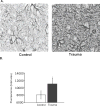Cardiac reactive oxygen species after traumatic brain injury
- PMID: 22172132
- PMCID: PMC3299814
- DOI: 10.1016/j.jss.2011.09.056
Cardiac reactive oxygen species after traumatic brain injury
Abstract
Background: Cardiovascular complications after traumatic brain injury (TBI) contribute to morbidity and mortality and may provide a target for therapy. We examined blood pressure and left ventricle contractility after TBI, and tested the hypothesis that β-adrenergic blockade would decrease oxidative stress after TBI.
Material and methods: Rodents received fluid-percussion injury or sham surgery, confirmed with magnetic resonance imaging (MRI) and histopathology. We followed recovery with sensorimotor coordination testing and blood pressure measurements. We assessed left ventricular ejection fraction using ECG-gated cardiac MRI and measured myocardial reactive oxygen species (ROS) with dihydroethidium. We randomized additional TBI and sham animals to postoperative treatment with propranolol or control, for measurement of ROS.
Results: Blood pressure and cardiac contractility were elevated 48 h after TBI. Myocardial tissue sections showed increased ROS. Treatment with propranolol diminished ROS levels following TBI.
Conclusions: TBI is associated with increased cardiac contractility and myocardial ROS; decreased myocardial ROS after β-blockade suggests that sympathetic stimulation is a mechanism of oxidative stress.
Copyright © 2012 Elsevier Inc. All rights reserved.
Figures






Comment in
-
Understanding the brain-heart axis in neurological trauma.J Surg Res. 2012 Mar;173(1):e33-5. doi: 10.1016/j.jss.2011.10.040. Epub 2011 Nov 19. J Surg Res. 2012. PMID: 22221598 No abstract available.
References
-
- Faul MXL, Wald MM, Coronado VG. Traumatic Brain Injury in the United States: Emergency Department Visits, Hospitalizations and Deaths 2002–2006. Centers for Disease Control and Prevention, National Center for Injury Prevention and Control; Atlanta (GA): 2010.
-
- Bybee KA, Prasad A. Stress-related cardiomyopathy syndromes. Circulation. 2008 Jul 22;118(4):397–409. - PubMed
-
- Clifton GL, Robertson CS, Kyper K, Taylor AA, Dhekne RD, Grossman RG. Cardiovascular response to severe head injury. Journal of neurosurgery. 1983 Sep;59(3):447–454. - PubMed
-
- Clifton GL, Ziegler MG, Grossman RG. Circulating catecholamines and sympathetic activity after head injury. Neurosurgery. 1981 Jan;8(1):10–14. - PubMed
-
- Robertson CS, Clifton GL, Grossman RG. Oxygen utilization and cardiovascular function in head-injured patients. Neurosurgery. 1984 Sep;15(3):307–314. - PubMed
Publication types
MeSH terms
Substances
Grants and funding
LinkOut - more resources
Full Text Sources

